Commercial Charbroiler Guide
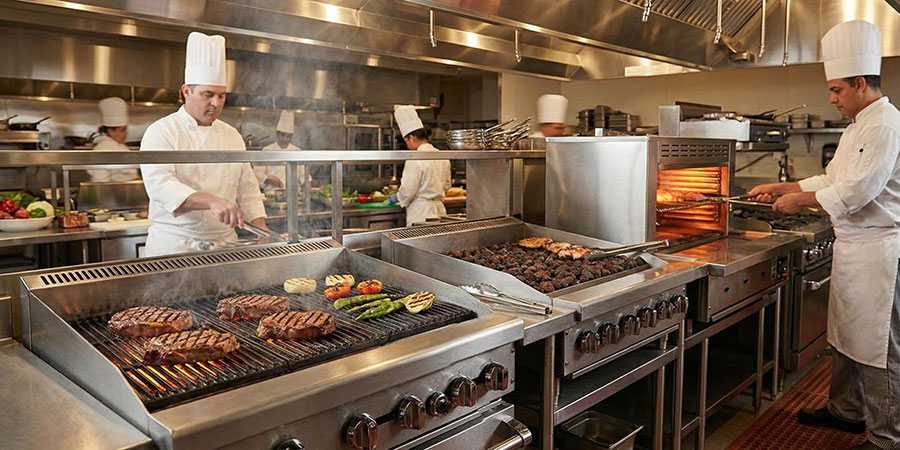
Table of Contents
Professional grilling equipment for authentic flavor and perfect sear marks
Commercial charbroilers are the workhorses behind the distinct smoky flavor and appetizing sear marks that define great grilled menu items. Unlike standard griddles that cook on a flat plate, charbroilers use open grates over a heat source - gas radiants, lava rocks, electric elements, or wood logs - to cook food directly. This design allows fats and juices to drip down and vaporize, creating the aromatic smoke that flavors burgers, steaks, seafood, and vegetables. Available in various fuel types and configurations, from compact countertop units to massive wood-burning display grills, charbroilers are essential for steakhouses, diners, and any operation wanting to bring the outdoor grilling experience inside the professional kitchen.
Types of Charbroilers
Commercial charbroilers are primarily categorized by their fuel source, which dictates the installation requirements, flavor profile, and operating costs.
Gas Charbroilers
Gas charbroilers are the industry standard for high-volume grilling, known for their powerful heat output and rapid recovery times. Available in natural gas or liquid propane configurations, these units offer immediate heat and precise flame control.

- Best Uses: High-volume steakhouses, burger chains, busy diners, general restaurant use
- Key Features: High BTU output, instant-on heat, durable construction, various heating media options (radiant, lava rock)
- Pros: Powerful performance, fast recovery, cost-effective fuel, familiar operation for chefs
- Cons: Requires gas line installation and robust ventilation, creates significant ambient heat
Electric Charbroilers
Electric charbroilers offer a flameless grilling solution with precise temperature control and high energy efficiency. They are ideal for kitchens where gas is unavailable or where reducing ambient kitchen heat is a priority.
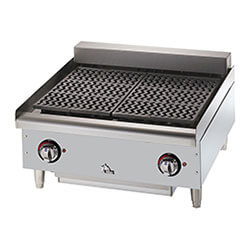
- Best Uses: Kitchens without gas connections, energy-conscious operations, facilities with strict ventilation codes
- Key Features: Consistent heating elements, lower ambient heat emission, often easier to clean
- Pros: Energy efficient, precise control, no gas leaks, cleaner operation
- Cons: Slower heat recovery than gas, higher electricity costs in some regions, may lack the intense "fire" flavor of gas/wood
Wood Burning Charbroilers
Wood burning charbroilers are the premium choice for chefs seeking authentic, wood-fired flavor and a dramatic visual presentation. These units burn real hardwood logs or charcoal to generate heat and smoke.

- Best Uses: Upscale steakhouses, open-kitchen concepts, specialty BBQ operations
- Key Features: Heavy-duty fireboxes, adjustable grilling surfaces, large wheels for grate adjustment
- Pros: Unmatched flavor complexity, visual appeal for display cooking, extremely high searing temperatures
- Cons: High fuel cost and labor (handling wood/ash), requires specialized ventilation and fire suppression, inconsistent heat requiring skilled operation
Placement Styles
Charbroilers are available in three main configurations to fit different kitchen layouts and volume requirements.
Countertop Charbroilers
Countertop models are the most versatile and common configuration, designed to sit on equipment stands or refrigerated chef bases. They maximize vertical space and allow for flexible kitchen arrangements.
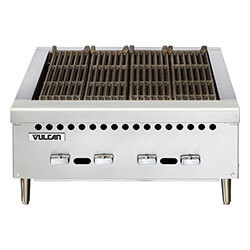
- Best For: Small to medium-volume kitchens, food trucks, caterers, lines with limited floor space
- Sizes: Typically 12" to 72" wide
- Benefits: flexible placement, lower initial cost, easy to swap out or upgrade
Free Standing Charbroilers
Free standing units are floor-mounted appliances, often integrated with a cabinet base for storage. These heavy-duty models are built for high-volume production and often feature wider cooking surfaces.

- Best For: Large banquet halls, high-volume steakhouses, institutional kitchens
- Sizes: 24" to 72"+ wide
- Benefits: Dedicated workspace, often includes storage, extremely durable construction
Modular Charbroilers
Modular units are designed to bank together with other equipment (like ranges and griddles) to create a seamless, custom cookline. They provide a uniform appearance and often share utility connections or shelving.

- Best For: New kitchen builds, custom cooklines, aesthetic-focused open kitchens
- Benefits: Seamless integration, professional appearance, efficient use of linear hood space
Range-Integrated Charbroilers
For kitchens with limited linear hood space, a commercial range with an integrated charbroiler top is an efficient solution. These all-in-one units combine standard open burners, a charbroiler section (typically 12-36 inches wide), and an oven base into a single footprint, eliminating the need for a separate equipment stand.

- Best For: Small kitchens needing multiple cooking methods in one unit, lines with limited width
- Benefits: Maximizes functionality in a single footprint, combines grilling and baking capabilities
Heating Methods & Media
For gas charbroilers, the "engine" that converts the flame into cooking heat is a critical selection factor. The heating medium determines heat distribution, flare-up control, and maintenance needs.
Radiant Charbroilers
Radiant charbroilers use angled metal shields (radiants) placed above the burners to absorb heat and radiate it upward to the grate. The angled design directs grease drips away from the flame, minimizing flare-ups.
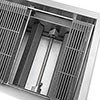
- Mechanism: Metal shields (cast iron or stainless steel) protect burners and radiate heat
- Performance: Even heat distribution, controlled flare-ups, fast preheat
- Maintenance: Easiest to clean; radiants can be removed and brushed/washed
- Best For: High-volume kitchens needing consistent performance and low maintenance
Lava Rock Charbroilers
Lava rock charbroilers use a bed of porous ceramic or natural rocks above the burners. These rocks catch drippings and vaporize them, creating intense smoke and flare-ups that contribute to a distinct "char-grilled" flavor.
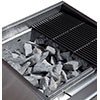
- Mechanism: Porous rocks sit on a grate above burners, holding and radiating heat
- Performance: High smoke generation for flavor, uneven heat if rocks aren't rotated
- Maintenance: High; rocks absorb grease and must be flipped/replaced regularly to prevent uncontrolled fires and rancid flavors
- Best For: Operations prioritizing a specific smoky flavor profile over ease of maintenance
Ceramic Briquette Charbroilers
Ceramic briquettes are a modern evolution of lava rocks, using uniform ceramic shapes (often pyramid or pillow-shaped) to provide the flavor benefits of rock media with better heat consistency.

- Mechanism: Uniform ceramic pieces create a radiant bed
- Performance: More even heat than natural lava rock, good heat retention
- Maintenance: Briquettes are self-cleaning to a degree (burn off grease) and last longer than lava rock
- Best For: Chefs wanting flavor enhancement with better consistency than lava rock
Infrared Charbroilers
Infrared charbroilers use specialized burners to emit infrared energy, heating the food directly rather than heating the air around it. This results in extremely high temperatures and rapid searing.
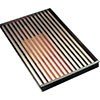
- Mechanism: Ceramic tiles or metal mesh burners generate infrared waves
- Performance: Extremely high heat (up to 1000°F+), instant searing, reduced kitchen heat load
- Maintenance: Delicate burner surfaces require careful cleaning
- Best For: Steakhouses needing to lock in juices instantly; operations wanting energy efficiency
Burner Quantity & Sizing
Selecting the right size and burner configuration ensures your charbroiler can handle peak service without wasting energy during slow periods.
Width & Cooking Zones
Charbroilers are typically sized in 12-inch increments, ranging from compact 12-inch models to expansive 72-inch units.
- Burner Spacing: Most models feature one burner every 6 to 12 inches.
- Heavy Duty: More burners (e.g., every 6 inches) provide tighter heat zones and higher total output.
- Standard Duty: Fewer burners (e.g., every 12 inches) reduce cost and gas consumption but offer less precise zoning.
- Zone Control: Individual controls for each burner allow chefs to create different heat zones across the width of the unit—for example, a "searing zone" on high heat and a "finishing zone" on low heat. This is essential for managing different proteins and doneness levels simultaneously.
Features & Accessories
Modern charbroilers offer various features to enhance versatility, ergonomics, and cooking results.
Grate Options
- Material Selection: Cast Iron: The industry standard for heat retention and defining sear marks. Requires seasoning but maintains high heat better for recovery. Stainless Steel: Easier to clean and resistant to rust, but loses heat faster than cast iron. Best for lighter duty or delicate items.
- Adjustable Grates: Allow chefs to tilt the cooking surface (flat or slanted) to control grease runoff and heat intensity. Slanting the grate away from the chef moves grease to the trough, reducing flare-ups.
- Reversible Grates: Many cast iron grates have two sides: a thin side for searing distinct grill marks into steaks, and a wider/flatter side for delicate items like fish or poultry that need more support.
Structural Features
- Splash Guards: High sides and back guards (tapered or straight) that contain grease splatter, protecting adjacent equipment and walls.
- Plate Rails: A cool-to-touch front ledge (3-6 inches wide) that allows chefs to set plates down for immediate plating directly off the grill.
- Cabinet Base: Provides enclosed storage for tongs, brushes, and cleaning supplies directly under the grill.
- Low Profile Design: Compact height units that sit lower on a stand, providing a more ergonomic cooking height for chefs, especially when placed on refrigerated bases.
- Modular Design: Units built to lock together with other equipment for a seamless battery.
Specialty Add-ons
- Rotisserie: Motorized spits for slow-roasting whole chickens or roasts over the charbroiler heat.
- Skewers: Specialized racks or slots for holding shish kabobs and satays.
- Smoker Boxes: Integrated or add-on boxes that hold wood chips to add specific wood smoke flavors (hickory, mesquite) to gas or electric units.
Selecting the Right Charbroiler
Production Volume & Menu
- High Volume (Steakhouse/Burger Chain): Gas radiant or infrared models with heavy-duty BTU ratings (up to 30,000+ BTU per burner). Look for free-standing or heavy countertop units.
- Medium Volume (Casual Dining): Standard radiant or ceramic briquette models.
- Flavor Focused: If "char-broiled" flavor is your main selling point, consider lava rock, ceramic briquette, or wood-burning units, but be prepared for the extra maintenance.
- Delicate Menu: For seafood and vegetables, electric or radiant gas models offer more controlled heat with fewer violent flare-ups than lava rock.
Ventilation Requirements
All commercial charbroilers produce significant smoke, grease, and heat, requiring a Type 1 commercial hood system.
- Wood Burning: Often requires separate ventilation systems or specialized spark-arresting hoods and fire suppression systems due to the solid fuel creosote buildup.
- Size: Ensure the hood extends at least 6 inches beyond the charbroiler on all sides.
Cleaning & Maintenance Capability
Be realistic about your staff's capacity for cleaning.
- Lowest Maintenance: Gas Radiant (brush grates, remove and wash radiants).
- Medium Maintenance: Ceramic Briquette (periodically flip/burn off, replace broken briquettes).
- Highest Maintenance: Lava Rock (frequent flipping, replacement, grease management) and Wood Burning (ash removal, flue cleaning, wood storage).
Installation & Maintenance
Daily Care
- Seasoning: Keep cast iron grates seasoned with oil to prevent sticking and rust.
- Brushing: Scrub grates vigorously with a wire brush during and after service while warm.
- Burn Off: Crank heat to high for 10-15 minutes at the end of the night to turn grease to ash.
- Grease Trough: Empty and clean the grease drip tray daily to prevent overflow and fire hazards. > Pro Tip: Adding a small amount of water to the drip tray at the start of a shift can prevent grease from baking onto the metal, making end-of-day cleanup significantly easier and reducing smoke from smoldering drippings.
Periodic Maintenance
- Inspect Radiants/Rocks: Check for cracks or degradation. Cracked radiants can damage burners; crumbled lava rocks cause uneven heat.
- Check Burners: Inspect gas ports for clogs (grease/carbon) that cause uneven flames.
- Ventilation: Professional hood cleaning is critical for charbroilers due to heavy grease vapor production.
Frequently Asked Questions
What is the difference between a radiant and lava rock charbroiler?
Radiant charbroilers use metal shields to distribute heat and are easier to clean with fewer flare-ups. Lava rock charbroilers use porous stones to hold heat and burn drippings, creating more smoke and flavor but requiring significantly more maintenance and cleaning.
Do I need a gas or electric charbroiler?
Gas is the standard for power and recovery speed, making it best for high volume. Electric is ideal if you don't have gas lines, need very precise temperature control, or want to reduce ambient heat in the kitchen.
How do I clean cast iron charbroiler grates?
While warm, scrape with a wire brush or scraper. At the end of the day, allow the unit to burn off residue, then wipe down. Periodically, grates can be soaked in degreaser, but they must be re-seasoned immediately to prevent rust.
Can I put a countertop charbroiler on a refrigerated chef base?
Yes, but you must ensure the chef base has a heat shield (marine edge) or adequate insulation top. A "low profile" charbroiler is often preferred here to keep the cooking surface at a comfortable working height.
What creates the "grill flavor"?
The flavor comes primarily from meat juices and fats dripping onto the hot heat source (radiant, rock, or wood) and vaporizing back up into the meat as aromatic smoke.
Shop Charbroilers
Featured Categories
- Gas Charbroilers - High-performance grilling for any volume
- Electric Charbroilers - Precise, energy-efficient grilling solutions
- Wood Burning Charbroilers - For authentic wood-fired flavor
- Countertop Charbroilers - Versatile space-saving options
- Commercial Gas Ranges with Charbroilers - All-in-one cooking stations
- Charbroiler Accessories - Grates, cleaners, and briquettes
Shop by Heating Method
Need help selecting the right commercial charbroiler? Contact our foodservice experts for personalized advice on fuel types, sizing, and installation.
Share This!